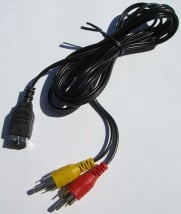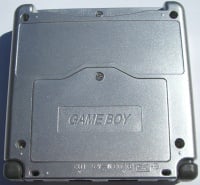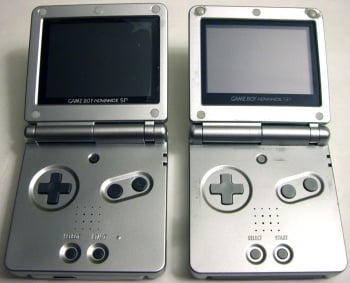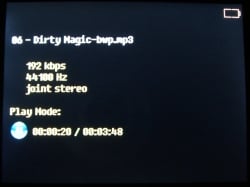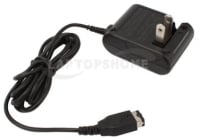- Joined
- Jan 3, 2008
- Messages
- 10,579
- Trophies
- 2
- Age
- 48
- Location
- From Where???
- Website
- wiki.gbatemp.net
- XP
- 5,535
- Country

<font color="red">GBAtemp.net review of the...</font>
<font size="5"><font color="#000080">K1 GBA SP</font></font>


SoC Designed by: K-Team
Sales by: K1GBA
Also Known As: K1, K-Team GBA SP, K1 SP
Review by Another World - completed 8/06/2012
Review Contents & Index:
Gamers remain nostalgic for the experiences of their youth, to the point of challenging their gaming choices from those of other gamers. Yet one system seems to have spanned a multitude of generations, making it a system that gamers and developers are usually in agreement upon. Partially due to its collection of timeless software, interesting peripheral concepts, and recognizable branding, but mostly to the fact that it was simply released at the right time, this handheld and its games have survived 2 system redesigns, 1 successor, and more than 10 years of gaming history. This system was none other than the Gameboy Advance, Nintendo’s 32-bit Sprite-based handheld.
Some companies have tried to capitalize on the nostalgia of the GBA-era of gaming by releasing GBA handheld clones, systems which are based in emulation. While these systems may look right or feel great, they have always suffered from a less than perfect compatibility rate. The K1 GBA SP is a “hardware clone” of the Gameboy Advance SP, utilizing a system on a chip design that mimics the GBA cartridge in modern DRAM. A design choice that has created some serious buzz as it may offer the possibility for perfect compatibility with all normal hardware GBA games and ROMs.
It would be rather difficult to review such a product without comparing it to the original GBA SP in some way, yet the goal of this review will be to discuss the positive and negative aspects of only the K1 GBA SP. The K1 GBA SP offers embedded 8-bit emulation, and due to the amount of available ROMs, these emulators will be discussed for their features more than for their compatibility. While many ROMs have been tested during the review process, a complete listing of working 8-bit ROMs will not be discussed or listed in this review.
Important GBAtemp Information:
GBAtemp has recently opened all reviews for user comments. Please remember that the comments must adhere to our strict guidelines. Do not post congratulatory comments or comments speculative in nature, negative in nature, or the like, that have nothing to do with the review or the review’s content. Such comments will be deleted without warning or explanation. Users should consider only posting well researched comments that further the overall effect of the review and nothing more.

I would like to thank K1GBA for supplying the review sample. K1GBA is the only official reseller of the newly designed K1 GBA SP unit. These units have a Product ID number of 00610603, which has been confirmed by both the K-Team and K1GBA as being fully upgradable units. Their free worldwide shipping and excellent customer service make http://www.k1gba.com an ideal place to purchase your K1 GBA SP. Their team has been incredibly patient and forth coming with K1 GBA SP related information. Without their help this review would probably never have been written.
<div class="reviewbreak"><a name="b"></a>Product Information</div>
The K-Team developed a system on a chip (SoC) design that allows the K1 GBA SP to run GBA ROMs and Homebrew on actual hardware. The K-Team is not responsible for the end result, they offer the SoC and its firmware for sale to interested manufactures. It is up to the manufacture to decide how best to implement the SoC, including such things as form factor, the ability to accept firmware updates, the inclusion of the K-Card interface device, and the type of hardware. For these reasons subtle differences may exist between different K1 GBA SP units. This makes it rather difficult to construct a list specifications that will remain true across multiple manufacturers and resellers.
The product information list included with this review was obtained from http://www.k1gba.com and may contain inaccurate information. The information collected from K1GBA was reworded for this review and as a result is not an exact copy of the original content. The included technical information list was compiled after discussions with the K-Team. The technical explanation paragraph that follows is a rewording of information received during these discussions.
Product Information:
The K1 GBA SP makes use of a special memory interface that allows a GBA cartridge interface to be "emulated" by a modern DRAM interface and DMA. The K-Card acts as an access device allowing the contents of the microSD card to be utilized by the SoC, it also doubles as a storage device for save files. The on-board DRAM is accessed only when the K-Card is used and functions by accepting the entire ROM and then executing it.
<div class="reviewbreak"><a name="c"></a>Contents and Packaging</div>
Contents:
The box is designed to appear like an official Nintendo product. The front of the box has an image of an official Gameboy SP and the graphics are completed with multiple Gameboy and Nintendo logos. Each side of the box is similar in nature while displaying images of the SP in different positions. The back of the box contains a Nintendo seal of approval that says “Original Nintendo Seal of Quality” and further includes trademarks and copyright dates. The warning area on the back of the box states that the LCD screen may have pixels that do not light up or turn off, and reminds the user that this is not a defect. The box continues to present an official product by listing actual GBA SP part numbers, such as AGS-101. The very last item on the content list states that an “instruction manual with warranty” is included, yet these things were not found in the box.<br><br>The AC adapter is unlike anything I have previously received with a Chinese video game system. The plug itself contains two straight ends that are not compatible with N. American outlets. The included travel adapter must be utilized in order to use this AC adapter. When connected, the plug functions just fine and the system charges without issue. The only real problem with the plug is that the travel adapter does not fit snugly. Any slight movement of the K1 GBA SP or the plug itself resulted in the travel adapter becoming disconnected. Thankfully, the K1 GBA SP supports the official Nintendo AC adapter, a product which allows for a much more stable charging situation.
The included AV cable utilize the same connection point as the AC adapter, making it specific to the SP-port and perhaps rather difficult to replace. The cables provide 1 video out signal and 1 audio out signal. The video transmits in a default resolution of 640x480, while the audio outputs a mono signal.<br><br>
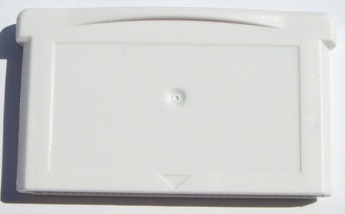
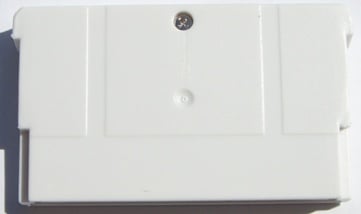 The K-Team SoC has been implemented into 2 types of GBA SP units. The first utilizes the SoC to run only retail game cartridges. This first system is being sold as an alternative upgrade to the official GBA SP, as it contains a modern LCD, louder sound output, and more. The second implementation of the SoC is in units which support the K-Card, a simple interface device that allows for the booting of ROMs and Homebrew. The K-Card is not a Flash Kit and will not function as such on other hardware. The K-Card accepts a microSD/SDHC card and allows for simple drag/drop ROM support. It also doubles as a storage device when GBA game saves stored in the DRAM are written to the microSD card.<br><br>
The K-Team SoC has been implemented into 2 types of GBA SP units. The first utilizes the SoC to run only retail game cartridges. This first system is being sold as an alternative upgrade to the official GBA SP, as it contains a modern LCD, louder sound output, and more. The second implementation of the SoC is in units which support the K-Card, a simple interface device that allows for the booting of ROMs and Homebrew. The K-Card is not a Flash Kit and will not function as such on other hardware. The K-Card accepts a microSD/SDHC card and allows for simple drag/drop ROM support. It also doubles as a storage device when GBA game saves stored in the DRAM are written to the microSD card.<br><br>

 The K-Card has the same dimensions, look, and feel, of a retail GBA cartridge. The two halves of the shell are secured using a micro-sized Phillips head screw. The microSD card slot is spring loaded and top mounted, making it fully accessible when the K-Card is inserted into the K1 GBA SP.
The K-Card has the same dimensions, look, and feel, of a retail GBA cartridge. The two halves of the shell are secured using a micro-sized Phillips head screw. The microSD card slot is spring loaded and top mounted, making it fully accessible when the K-Card is inserted into the K1 GBA SP.
<div class="reviewbreak"><a name="d"></a>Design and Impressions</div><br>The K1 GBA SP is being sold by K1GBA in a choice of three colors, which are blue, black, or silver. The review unit is the silver color, which is a metallic shade of silver. The d-pad and all buttons are a darker shade of gun metal grey. This second shade complements the metallic silver, a color which sparkles in direct sunlight. On the left side of the unit is a volume slider. The slider moves smoothly from top to bottom in a firm motion that is perfect for dialing in an exact volume setting. On the right side of the unit is the power slider, power LED, and charging LED. When the power slider clicks into place the power LED will illuminate a shade of lime green when charged or bright red when power is running low. The charging LED glows amber in color while the unit is plugged in, and will turn off when the unit is fully charged. On the back of the unit are two areas for wrist straps or cell phone style charms. Also found here is the extension port and the charting port, both of which require plug-ends designed specifically for the GBA SP. On the outer edges of this area are the two shoulder buttons, labeled “L” and “R”. The face of the unit has a d-pad, 2 buttons labeled “A” and “B”, a round select button, a similar start button, and a center backlight button that doubles as the function shortcut key. Above the start and select buttons are words etched into the plastic which denote their function. Located on the top of the unit is a modern LCD, 3 inches in size, which is surrounded by a black border completed with a “Gameboy Advance SP” logo.<br><br>The K1 GBA SP is a clone of the official SP, right down to the details on the shell. When comparing the clone to the original, there are only a few differences. The first of which is a small bump in the plastic to the right of the start button. It appears to be a simple design difference that serves as a reminder of where the start button is located. Other subtle differences are the missing “Nintendo” logo from the top of the shell and the barcode information sticker from the back of the shell. The hinge spring on the K1 GBA SP does not click into place like on the official SP. Additionally, the spring tension often causes the LCD to pop back into the traditional SP angled position, making it rather difficult to keep the LCD pushed all the way back.<br><br>

K1 GBA SP at lowest brightness setting vs. AGS-001The Sharp LCD used by the K1 GBA SP is completely different from the one used on the official SP. The K1 GBA SP LCD is approximately the same width as the official SP LCD, while being approximately 1/8 of an inch higher. Additional differences are its higher resolution, multiple modes of scaling, and 5 levels of brightness. The higher resolution of the modern LCD causes some graphics to appear different than on the original SP, somewhat less-sharp in nature. This phenomenon is mostly noticeable on still graphics such as game start screens. The default image scaling of the K1 GBA SP is 320x240, while the second mode maintains the same width it lessens the height to something that more closely resembles the original SP. The LCD supports 5 levels of brightness, the highest of which is well suited for outdoor gaming. When enjoying MP3s it is possible to turn off the backlight, however, this last setting does not turn off the LCD.
While the directional pad and buttons mimic the look and feel of the official SP, they are not able to capture the same responsiveness. I have yet to use a Chinese made “clone” handheld that offered a control experience equal to that of the original, and sadly this is what hurts the K1 GBA SP the most. The d-pad itself is extremely responsive, as are the buttons, when enough pressure is applied. There is no sweet spot, pushing the very edges of the d-pad does not help for example, the issue appears to be purely pressure related. When a movement or attack fails to register, it can mean the difference between enjoyment and frustration, and I have been extremely frustrated with the input of the “B” button. The “B” button fails to register more often than not and must be pushed down as far as possible for it to work.
<div class="reviewbreak"><a name="e"></a>Set-up and Usage</div>
There are two K1 GBA SP units produced which can accept firmware updates, however, only one is being sold by K1GBA.com. The unit stocked by K1GBA has a Product ID number of 00610603. This unit currently ships with the most up-to-date firmware, dated 6/14/12.
Before playing with the K1 GBA SP, it is advisable to fully charge the unit. Charging can be accomplished by using either the included AC adapter, a 3rd party adapter, or the official SP AC adapter. It will take approximately 3-4 hours to fully charge the unit from a completely drained battery. After which the unit should provide approximately 4-6 hours of gaming, depending on the level of brightness, how long one spends on the main menu, etc. The main menu runs at at a higher clock speed than games, causing the battery to drain much more quickly. When the power LED turns red the system will hold enough charge to game for approximately 1-2 hours.
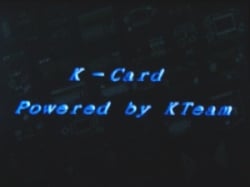
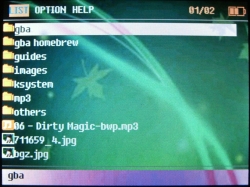 The microSD card must be placed into the K-Card with its contact-teeth pointing towards the bottom of the K-Card. When the K-Card is inserted into the K1 GBA SP the teeth of the microSD card will point up. When the unit is first powered-on, a K-Team splash screen will appear. The splash screen will remain for approximately 3 seconds and then be replaced by a microSD directory structure listing. It is possible to customize the splash screen and background image by simply adding the appropriately named .JPG images to the ROOT directory. For the splash screen the file must be named userlogo.jpg and for the background image the file must be named bg.jpg. While the firmware should be able to scale down images, some larger resolution background images caused the menu to display indecipherable garbled graphics. As a result, when implementing a custom image a resolution of 320x240 is recommended.<br><br>
The microSD card must be placed into the K-Card with its contact-teeth pointing towards the bottom of the K-Card. When the K-Card is inserted into the K1 GBA SP the teeth of the microSD card will point up. When the unit is first powered-on, a K-Team splash screen will appear. The splash screen will remain for approximately 3 seconds and then be replaced by a microSD directory structure listing. It is possible to customize the splash screen and background image by simply adding the appropriately named .JPG images to the ROOT directory. For the splash screen the file must be named userlogo.jpg and for the background image the file must be named bg.jpg. While the firmware should be able to scale down images, some larger resolution background images caused the menu to display indecipherable garbled graphics. As a result, when implementing a custom image a resolution of 320x240 is recommended.<br><br>
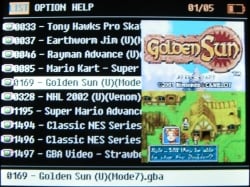
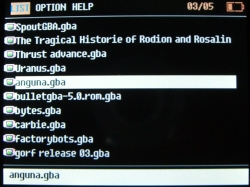 Browsing the directory structure is completely intuitive, the d-pad controls the browsing of the list (up or down) while "A" executes and "B" cancels a selection. Pressing right or left will page through the directory structure 1 listing at a time, with each listing comprised of 10 file or folders. At the top of the screen are additional menu items and displayed at the bottom of the screen is the currently highlighted file name. File names within the directory listing are truncated. Thankfully, the area at the bottom of the screen will scroll each highlighted name from right to left, making them extremely easy to read when game artwork is taking up a portion of the screen.<br><br>
Browsing the directory structure is completely intuitive, the d-pad controls the browsing of the list (up or down) while "A" executes and "B" cancels a selection. Pressing right or left will page through the directory structure 1 listing at a time, with each listing comprised of 10 file or folders. At the top of the screen are additional menu items and displayed at the bottom of the screen is the currently highlighted file name. File names within the directory listing are truncated. Thankfully, the area at the bottom of the screen will scroll each highlighted name from right to left, making them extremely easy to read when game artwork is taking up a portion of the screen.<br><br>
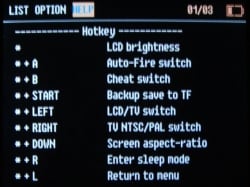
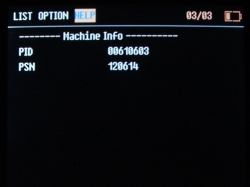 Pressing SELECT will move through the menu items one at a time from left to right. Pressing the left shoulder button will move 1 item to the left and stop on the first item, while pressing the right shoulder button will move 1 item to the right and stop on the last item. The first item is "LIST" which simply returns to the directory browsing view. The second item is "OPTION", which provides some basic behavioral tweaks. The third item is "HELP" which lists the function shortcut keys as well as other important system related information.<br><br>
Pressing SELECT will move through the menu items one at a time from left to right. Pressing the left shoulder button will move 1 item to the left and stop on the first item, while pressing the right shoulder button will move 1 item to the right and stop on the last item. The first item is "LIST" which simply returns to the directory browsing view. The second item is "OPTION", which provides some basic behavioral tweaks. The third item is "HELP" which lists the function shortcut keys as well as other important system related information.<br><br>
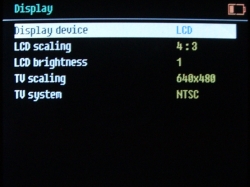
 The option menu contains settings for the system language, display output, keypad, file filter, splash screens, and an auto-sleep countdown setting. The first option is a language setting which allows the user to adjust the system language between 1 of 8 possible choices (English, simplified Chinese, traditional Chinese, Japanese, Korean, German, French, Spanish). The display options contain settings for LCD or TV output, LCD and TV scaling (4:3, 3:2, 640x480, 480x320), LCD brightness (0-5), and TV system (NTSC, PAL). The audible tone which the keypad makes can be turned off in the keypad settings, also the key press delay and key press repeat delay can be adjusted (0.0s-MAX). Files can be hidden by extension in the file filter setting both globally and on a per-file basis (Game, Save, MP3, JPG, TXT). The boot-up screen and GBA BIOS splash screen can be turned on or off in the miscellaneous section. Also in this section is an option for an automatic sleep countdown (OFF-10min). The sleep mode will initialize when a button has not been pressed for the set amount of time, to wake the system back up simply press any of the front facing buttons, except for the backlight button.
The option menu contains settings for the system language, display output, keypad, file filter, splash screens, and an auto-sleep countdown setting. The first option is a language setting which allows the user to adjust the system language between 1 of 8 possible choices (English, simplified Chinese, traditional Chinese, Japanese, Korean, German, French, Spanish). The display options contain settings for LCD or TV output, LCD and TV scaling (4:3, 3:2, 640x480, 480x320), LCD brightness (0-5), and TV system (NTSC, PAL). The audible tone which the keypad makes can be turned off in the keypad settings, also the key press delay and key press repeat delay can be adjusted (0.0s-MAX). Files can be hidden by extension in the file filter setting both globally and on a per-file basis (Game, Save, MP3, JPG, TXT). The boot-up screen and GBA BIOS splash screen can be turned on or off in the miscellaneous section. Also in this section is an option for an automatic sleep countdown (OFF-10min). The sleep mode will initialize when a button has not been pressed for the set amount of time, to wake the system back up simply press any of the front facing buttons, except for the backlight button.
The Help menu contains a listing of the function short-cut keys. The function short-cut keys are simple on or off toggles. For example, the auto-fire mode is adjusted using the in-game menu, but to turn this setting on or off on-the-fly the function short-cut key can be utilized. Also found in the this menu is a listing of supported file types (.GBA, .NES, .PCE, .SMS, .GG, .SG, .GBC, .GB, .SGB, .MP3, .JPG, .ZIP, .TXT) and the system machine info. The system machine information includes the Product ID number and the current firmware revision date.
<p>Function Short-cut Keys:
* - LCD Brightness
* + A - Auto-fire Switch
* + B - Cheat Switch
* + START - Backup Save to microSD
* + LEFT - Toggle LCD/TV Mode
* + RIGHT - Toggle TV NTSC/PAL Mode
* + DOWN - Screen Aspect-ratio
* + R - Enter Sleep Mode
* + L - In-game Menu</p><br>The K1 GBA SP offers some additional features, including a text reader, image viewer, and MP3 player. The text reader is used for both reading and in-game guides. It is limited by the fact that it can only display ANSI/UTF-8 .TXT files. Text which has not been formatted to fit the screen can be scrolled left, right, up, or down, using the directional pad. The image viewer currently only supports .JPG images, of which size and resolution do not appear to matter. However, loading larger images will take longer, but once images are loaded they can be zoomed in or out by pressing the shoulder buttons (L - out, R - in). Images can also be scrolled left, right, up, or down using the directional pad. MP3 playback supports both CBR and VBR MP3 files. While playing music, the screen will display the file name, kbps, Hz, audio type (IE: 192 kbps, 44100 Hz, joint stereo), the duration of play, and the total length of the audio file. The MP3 player is rather basic and only supports pause and play functionality via the the "A" button. Pressing the directional pad either up or down will reset the playback position to zero. MP3 files are a played according to their directory order, however, pressing START will initialize a random playback mode. No matter which additional feature is being used, the "B" button always cancels by returning to the last browsed directory.<br><br>
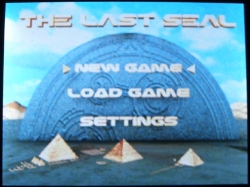
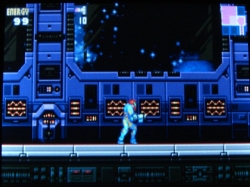
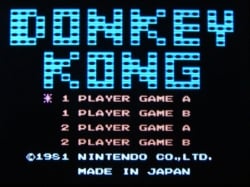 <br>
<br>


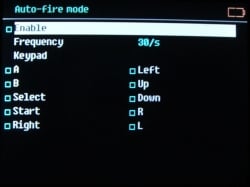 Highlighting a .GBA file and then pressing "A" will launch the GBA BIOS splash screen. When the splash screen is disabled the LCD will flash once before the file loads. The firmware currently does not patch Homebrew with bad headers. A sure sign that a Homebrew requires a header fix is when the splash screen displays a garbled Nintendo logo. To patch a Homebrew file simply open it with GBA Tool Advance and click the "Fix header" button.
Highlighting a .GBA file and then pressing "A" will launch the GBA BIOS splash screen. When the splash screen is disabled the LCD will flash once before the file loads. The firmware currently does not patch Homebrew with bad headers. A sure sign that a Homebrew requires a header fix is when the splash screen displays a garbled Nintendo logo. To patch a Homebrew file simply open it with GBA Tool Advance and click the "Fix header" button.
An in-game menu is available for all files under 32MB in size. Files which are 32MB make full use of the allocated memory leaving no free room for the menu patch. To access the in-game menu while actively gaming, the function shortcut key *+L must be pressed. (* refers to the backlight button). After the menu has been loaded, game cheats can be turned on or off, the game guide can be read, and an auto-fire mode can be adjusted. Game guides must be ANSI/UTF-8 .TXT files, named the same as the .GBA file you wish to associate it with, and placed into the same directory (IE: Xxx.GBA.TXT or Xxx.ZIP.TXT). Game guides make use of the text reader and as a result utilize the same control scheme. Cheats can be turned on or off on-the-fly, they do not permanently patch the .GBA file, and in most circumstances progress should be correctly stored in the save file. The auto-fire mode can be associated with any number of input buttons at the same time, using a global frequency of repetition (2, 6, 15, 30 seconds). It is possible to enable cheats and other in-game menu features before a ROM has been executed, thus allowing 32MB ROMs to experience the benefits of the K1 GBA SP. To accomplish this, simply highlight the ROM and then hold down the "A" button. A second menu will pop-up offering options such as Open, Delete, Config, and Cancel. Selecting the Config option will load the in-game menu. To turn on or off these options when gaming, make use of the function shortcut keys.
All GBA saves are stored in the DRAM and will not remain so after the unit has been powered off. Saves will be automatically written to the microSD card when the in-game menu is accessed. For 32MB games that do not have access to the in-game menu while gaming, or for any game that requires a quick save back-up, pressing the function short-cut *+START will write the save from DRAM to the microSD card.
For those interested in continuing EMU saved games on the K1 GBA SP, Shuny has created a tool which will convert EMU .SAV files to the K1 GBA SP format. To use the tool, simply drag/drop an EMU save onto the .EXE and watch as it instantly outputs a properly formatted save file. After using the tool be sure to change the file name to Xxx.GBA.SAV as this is the K1 GBA SP recognized file name.
<p>K1 GBA SP Converter v1.01:
 Download
Download
</p>
<div class="reviewbreak"><a name="f"></a>Embedded 8-bit Emulation</div><br>


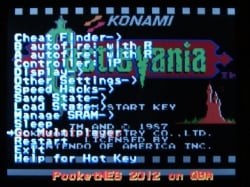
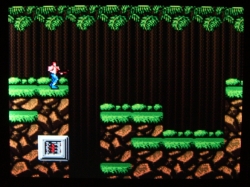
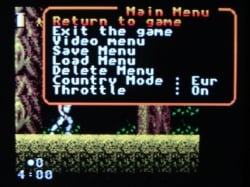
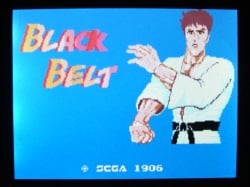 The K1 GBA SP includes embedded emulators capable of simulating some rather enjoyable 8-bit experiences. Currently the system supports the NES, Gameboy, Gameboy Color, Gamegear, Master System, and PC-Engine/TurboGrafx-16 systems. The firmware allows for direct ROM booting, simply click on an associated file (IE: .NES, .GG, etc) and the emulator will begin to run.
The K1 GBA SP includes embedded emulators capable of simulating some rather enjoyable 8-bit experiences. Currently the system supports the NES, Gameboy, Gameboy Color, Gamegear, Master System, and PC-Engine/TurboGrafx-16 systems. The firmware allows for direct ROM booting, simply click on an associated file (IE: .NES, .GG, etc) and the emulator will begin to run.
The emulators appear to not be completely original code but enhanced versions of popular Homebrew projects. After speaking with various sources and completing testing for this review, I have concluded that the included emulators are enhanced copies of PocketNES, Goomba Color/Goomba Paletted, SMSAdvance, and PCEAdvance. While they retain a similar compatibility, each emulator has been enhanced for the K1 GBA SP. In some instances this simply means the adjustment of in-emulator menus and the removal of options not supported by the K1 GBA SP. The custom build of PocketNES, however, is based on work completed by Maxzhou88 and includes updated mapper support for ShenZhen Nanjing Technology games. There is no known way to flash emulator updates to the firmware, and as a result all future updates will be at the discretion of the K1 GBA SP firmware author.
All tested files which were listed in various compatibility lists functioned as expected. The multiplayer link function of PocketNES, known to have issues with generic link cables, performed perfectly from K1 GBA SP-to-official SP. Emulators utilize the systems original aspect ratio which can only be adjusted according to the K1 GBA SP options. There are currently no emulator specific options for display modes such as full screen, stretch mode, etc. Save-states are written to a virtual SRAM that will remain in DRAM until the unit is powered-off. Writing the SRAM saves out to the microSD card can be accomplished by simply accessing the K1 GBA SP in-game menu or by executing the *+START function shortcut. In regards to the in-game menu, it functions with all embedded emulation but with limited accessibility. Game cheats, for example, do not function as they are associated only with GBA files.
<p>PCEAdvance Tip:
If a USA ROM fails to work then it may be encrypted. Use the application PCEToy to decrypt ROMs by typing pcetoy.exe decrypt "ROM_NAME.pce" into a DOS prompt.
 PCEToy32
PCEToy32
</p>
Some of the current embedded emulators suffer from various speed issues, it does not appear that the embedded emulators are accessing the higher CPU clock speeds. Official comments mention that the CPU can be clocked to 150Mhz, and if properly utilized could bring future possibilities to the K1 GBA SP. The K-Team has expressed an interest in development units, designed for feature upgrades, but they have no current plans to released an SDK of any kind. It looks like it may be up to the GBA Homebrew community to see what emulation, application and Homebrew possibilities the K1 GBA SP has to offer.
<div class="reviewbreak"><a name="g"></a>Performance</div>
Each of the tested GBA ROM files was checked by CRC against a known goodset listing. ROM files were tested on the K1 GBA SP, on an official GBA SP via a Slot-2 Flash Kit, and on PC based emulation. The latest revisions of Homebrew projects were tested for this review. Certain retail carts were tested on the system, each cart was additionally tested on an official SP. A 2 GB Japanese Kingston microSD card, a 4 GB Taiwan Class-4 Kingston microSD card, and an 8 GB Class-6 Transcend microSD card were used for all testing. Each microSD card was properly formatted using the Panasonic Formatter v3.1.
Files were chosen based on their inability to run on “clone” systems or for their unique features. Each file was tested for a minimum of 30 minutes while some were tested for more than an hour. During testing the in-game menu was accessed and many of the systems features and options were utilized, however, each available option was not tested with each file.
Each result is listed below by Homebrew, GBA ROM name, or GBA cartridge name followed by a color coded phrase. Green colored phrases mean the file performed as expected with no serious problems. Blue colored phrases mean the file performed with some problems. Problems could include speed issues, compatibility problems, graphical issues, in-game menu issues, etc. Red colored phrases mean that the file failed to run.
GBA ROM Compatibility:
Every normal hardware GBA game cartridge that I tried on the system worked. The only major problem was with the contact points. I was unable to get a single cartridge working the first time. The K-Card does not suffer from this problem, and it has lead to inclusive findings. It is possible that the aging GBA cartridges available for testing were the cause of the issue, however, each of these same cartridges worked correctly when tested on an official SP and a Game Boy Micro.
Homebrew compatibility is acceptable but rather disappointing in regards to older GBA Homebrew projects and relatively polished releases. It was surprising to find that projects such as PocketRaider, G.O.R.F., and Dangerous Xmas were unplayable, while these same projects functioned perfectly on an official SP.
<div class="reviewbreak"><a name="h"></a>Conclusion</div>
The K-Teams SoC is the first real GBA hardware solution available to manufacturers. The K1 GBA SP implements this solution into a recognizable and popular form factor. Together they offer gamers the opportunity to experience ROMs, Homebrew, and emulation on a device that aims to be the next evolution in GBA-era gaming.
The K1 GBA SP begins the GBA experience with a shell that could easily pass as an official SP. The shell is extremely smooth to the touch, is incredibly comfortable to hold, and folds up small enough to fit into almost any pocket. The design of the K1 GBA SP so closely matches an official SP that even the same SP-specific ports were implemented. The choice of ports maintains the feel of the original Nintendo design, but does so during a time of micro USB charging solutions, standard 3.5mm headphone jacks and AV-out cables. The backwards compatibility for original SP users will be a welcomed feature while new users will suffer as they attempt to tracking down 8+ year old adapters or cheaply manufactured modern-day 3rd party substitutions.
The K1 GBA SP Product ID 00610603 units make use of a Sharp 3in LCD display. The display is incredibly bright and offers an experience that quickly reminds gamers that they are indeed holding a modern remake of the Nintendo SP. Graphics are rendered in a higher resolution across a default image scaling of 320x240. As a result, sprites will look larger than on the original SP and may appear somewhat blurred around the edges. While at times some static images such as start screens and intro credits may not appear as one remembers them, this phenomenon is truly not noticeable while gaming.
Original retail GBA cartridges, pirated cartridges, ROMs, and Homebrew are supported by the K1 GBA SP. Unlike the official SP, the K1 GBA SP lacks native hardware support for GB/GBC ROMs and cartridges. GBA ROMs and Homebrew are limited to units that support the K-Card, a simple interface device which allows for the storage of such files via microSD/SDHC cards. The K-Card, and the ability to play ROMs and Homebrew, is the main selling point of the K1 GBA SP design. More so than the ability to play retail cartridges, as no single cartridge used during the review process worked the first time. Every single retail cartridge required being seated multiple times, something that was not experienced when the same cartridges were tested on official SP hardware. The issue could have been the aging contacts of the available cartridges or a flaw in the choice of connectors, yet the problem did exist and make the feasibility of cartridge usage something to consider.
On occasion, a ROM or Homebrew failed to function as expected. Some ROMs simply had missing elements such as sound, while others suffered from obvious slow-down. The K1 GBA SP SoC has been designed to do what the SP did while running on a single chip. This means that the hardware solution is already available, and after talking with the K-Team, I truly believe that firmware updates can perfect the rendering of ROMs, Homebrew, and cartridges on this choice of hardware. The only obstacle is placing our faith in the continued support of the developer behind the Product ID 00610601 and 00610603 units. K1GBA has assured me that a firmware upgrade is in the works. The firmware developer has posted on numerous forums stated that the products are indeed receiving updates. My comments about what should be included, what needs to be addressed, and what already works great, has been forward on to the developer. Further more, the K-Team has stated that they wish to see the K1 GBA SP perfected and have asked for a list of all problem files. Their honest desire to help, and the opportunity to have bug reports forward to those that matter, has instilled the upmost confidence in my ability to believe that these issues can be addressed through simple firmware upgrades.
The most important aspect of gaming is the ability of the directional pad and input buttons to register user interactions with an acceptable level of responsiveness. It was here that the K1 GBA SP suffered, with the recognition of input received only through increasing levels of force. While each directional input was tolerable, the “B” button simply would not respond unless pushed down until it completely stopped. Often it gave the feeling of wrong doing, as if pushing so hard would eventually break the system. The flawed choice of input buttons seems to be limited to certain builds of the K1 GBA SP. Early prototype reports described the directional pad and buttons as being very responsive, while Product ID 00610601 and 00610603 reports have equally described a similar experience. While some users will most undoubtedly alter their game playing techniques to not only accommodate the input experience, they will eventually grow accustomed to it. However, there remains the possibility that other units may be produced with an unresponsive button. To put it all into perspective the entire experience would need to be described with a few examples: I was unable to drive and shoot at the same time while playing Spy Hunter. Similarly, it is next to impossible to run and jump while playing any of the classic Super Mario Bros. games. While playing Double Dragon and River City Ransom EX, it was impossible to execute back-to-back attacks as the ability to push the “B” button hard enough began to hurt my thumb. User reports have confirmed the requirements of the buttons, while none have confirmed problems with which I experienced. Leading me to believe that perhaps the "B" button flaw is limited only to the review unit.
The K1 GBA SP does so many things right in such a small package. It has an extremely loud speaker that offers not only enjoyable gaming experiences but also clearly decoded MP3 playback. The system implements a modern day LCD with 5 exceptional levels of brightness. Multiplayer gaming of GBA ROMs, cartridges, and NES emulation is possible with an official SP. The TV-out functionality makes the handheld a portable console capable of displaying not only GBA games and Homebrew, but 8-bit emulation and interpreters onto a much larger screen. The system supports cartridge hot-swapping, direct ROM booting, customizable background images, cheats, auto-fire, most Slot-2 Flash Kits, 5-6 hours of battery life, an image viewer, a text reader, soft-reset, and more.
I only hope that the next firmware update addresses the compatibility issues, both ROM and Homebrew, found during review testing. It would be wonderful to see Homebrew header patching added to the next firmware update as well. Hopefully game art issues will also be addressed, as some game art is incorrectly associated with Homebrew files and some game art is not displaying at all. Finally, the ability to set the function shortcut key (L+R+A, perhaps?) to one of our choosing will hopefully be considered, as relying on the only backlight button seems like a poor decision.
As long as the community continues to report compatibility issues and the system continues to be updated, the K1 GBA SP has the possibility of providing an exceptional experience. The K-Team has done a remarkable thing with their SoC and I can only hope that future implementations of it are done so with better directional pad and button support, as this design flaw is truly the only one worth discussing.
<font color="green">Pros:</font>
<font color="green">+</font> Hardware based GBA solution
<font color="green">+</font> Dedicated graphic and sound hardware
<font color="green">+</font> 150MHz CPU
<font color="green">+</font> SP form factor, encased in a top quality shell
<font color="green">+</font> High volume from a nice quality speaker
<font color="green">+</font> Modern Sharp 3in LCD with 5 levels of brightness
<font color="green">+</font> Original SP adapter support
<font color="green">+</font> ROM and cartridge support
<font color="green">+</font> microSDHC support
<font color="green">+</font> Cheats, in-game guide, auto-fire
<font color="green">+</font> Image viewer, MP3 player, text reader
<font color="green">+</font> Firmware updates possible, can address compatibility
<font color="red">Cons:</font>
<font color="red">-</font> Directional pad and button input issues
<font color="red">-</font> SP-specific adapter ports
<font color="red">-</font> GBA Homebrew compatibility not equal to actual hardware
<div class="reviewbreak">
 </div>
</div>
Links:
Official Reseller
This review was written for GBAtemp.net ONLY. The article and included photos are the property of Another World and published by permission for GBAtemp.net. Research was conducted by contacting other K1 GBA SP users, Homebrew development programmers, the K-Team, K1GBA.com, and by reading various articles about the device and its hardware.
Special thanks to Shaunj66 and Costello. Without GBAtemp this review would not have been possible.
Special thanks to K1GBA for providing the review sample.
Special thanks to the K-Team for some great conversations
Special thanks to Abra for providing stuff that made this review possible.
Thanks to Rain for photoshop skills
Thanks to the Bura boys for the use of their hardware
Thanks to KiwiSheepFucker for ignoring me during this entire review.
Thanks to the GBAtemp community for answering questions when I could not.
Thanks to the Offspring for providing the theme music of this review!
If you see this review on any other site please let Another World know by PM.
<font size="5"><font color="#000080">K1 GBA SP</font></font>


SoC Designed by: K-Team
Sales by: K1GBA
Also Known As: K1, K-Team GBA SP, K1 SP
Review by Another World - completed 8/06/2012
Review Contents & Index:
- <a style="text-decoration: none;" href="#a">Introduction</a>
- <a style="text-decoration: none;" href="#b">Product Information</a>
- <a style="text-decoration: none;" href="#c">Contents and Packaging</a>
- <a style="text-decoration: none;" href="#d">Design and Impressions</a>
- <a style="text-decoration: none;" href="#e">Set-up and Usage</a>
- <a style="text-decoration: none;" href="#f">Embedded 8-bit Emulation</a>
- <a style="text-decoration: none;" href="#g">Performance</a>
- <a style="text-decoration: none;" href="#h">Conclusion</a>
Gamers remain nostalgic for the experiences of their youth, to the point of challenging their gaming choices from those of other gamers. Yet one system seems to have spanned a multitude of generations, making it a system that gamers and developers are usually in agreement upon. Partially due to its collection of timeless software, interesting peripheral concepts, and recognizable branding, but mostly to the fact that it was simply released at the right time, this handheld and its games have survived 2 system redesigns, 1 successor, and more than 10 years of gaming history. This system was none other than the Gameboy Advance, Nintendo’s 32-bit Sprite-based handheld.
Some companies have tried to capitalize on the nostalgia of the GBA-era of gaming by releasing GBA handheld clones, systems which are based in emulation. While these systems may look right or feel great, they have always suffered from a less than perfect compatibility rate. The K1 GBA SP is a “hardware clone” of the Gameboy Advance SP, utilizing a system on a chip design that mimics the GBA cartridge in modern DRAM. A design choice that has created some serious buzz as it may offer the possibility for perfect compatibility with all normal hardware GBA games and ROMs.
It would be rather difficult to review such a product without comparing it to the original GBA SP in some way, yet the goal of this review will be to discuss the positive and negative aspects of only the K1 GBA SP. The K1 GBA SP offers embedded 8-bit emulation, and due to the amount of available ROMs, these emulators will be discussed for their features more than for their compatibility. While many ROMs have been tested during the review process, a complete listing of working 8-bit ROMs will not be discussed or listed in this review.
Important GBAtemp Information:
GBAtemp has recently opened all reviews for user comments. Please remember that the comments must adhere to our strict guidelines. Do not post congratulatory comments or comments speculative in nature, negative in nature, or the like, that have nothing to do with the review or the review’s content. Such comments will be deleted without warning or explanation. Users should consider only posting well researched comments that further the overall effect of the review and nothing more.

I would like to thank K1GBA for supplying the review sample. K1GBA is the only official reseller of the newly designed K1 GBA SP unit. These units have a Product ID number of 00610603, which has been confirmed by both the K-Team and K1GBA as being fully upgradable units. Their free worldwide shipping and excellent customer service make http://www.k1gba.com an ideal place to purchase your K1 GBA SP. Their team has been incredibly patient and forth coming with K1 GBA SP related information. Without their help this review would probably never have been written.
<div class="reviewbreak"><a name="b"></a>Product Information</div>
The K-Team developed a system on a chip (SoC) design that allows the K1 GBA SP to run GBA ROMs and Homebrew on actual hardware. The K-Team is not responsible for the end result, they offer the SoC and its firmware for sale to interested manufactures. It is up to the manufacture to decide how best to implement the SoC, including such things as form factor, the ability to accept firmware updates, the inclusion of the K-Card interface device, and the type of hardware. For these reasons subtle differences may exist between different K1 GBA SP units. This makes it rather difficult to construct a list specifications that will remain true across multiple manufacturers and resellers.
The product information list included with this review was obtained from http://www.k1gba.com and may contain inaccurate information. The information collected from K1GBA was reworded for this review and as a result is not an exact copy of the original content. The included technical information list was compiled after discussions with the K-Team. The technical explanation paragraph that follows is a rewording of information received during these discussions.
Product Information:
- Full compatibility with normal hardware GBA games and ROMs.
- Support for official GBA cartridges
- Support for pirated GBA cartridges
- Official and Unofficial GBA link cable support (K1-K1 or K1-SP)
- Support for the official GBA SP charger
- Support for the official GBA SP battery pack
- Support for the official GBA SP headphone adapter
- TV-out via a GBA SP-specific AV cable. (Mono audio)
- In-game menu, allows for soft-resetting back to the main firmware menu
- MP3 playback functionality
- Text reading functionality
- JPG viewer
- In-game guide support (ANSI/UTF-8 .TXT)
- GBA cheat support
- High-quality LCD with 5 levels of brightness
- Built in LCD scaling engine
- Front facing speaker, louder than the official GBA SP
- microSD/SDHC support (up to 32 GB), no speed limitations
- Function shortcut keys (*+L for in-game menu, etc)
- Built in interrupt controller for cartridge hot-swapping
- Game preview picture support (based on internal GameID)
- Ability to change the power-on and background images
- Multiple language support
- Zipped ROM file on-the-fly decompression
- Dual Core system - ARM7+ARM9 compatible
- CPU - 16.67 MHz (up to 150 MHz)
- DRAM - 50 MHz
- Frame Rate - 60 fps
- Graphics - Dedicated GPU hardware circuits
- Sound - Dedicated SPU hardware circuits
- LCD - Sharp 3"
- Battery - 3.7v 700mAh Li-ion rechargeable
- Power Consumption - 80mAh on boot-up, < 80mAh while gaming
The K1 GBA SP makes use of a special memory interface that allows a GBA cartridge interface to be "emulated" by a modern DRAM interface and DMA. The K-Card acts as an access device allowing the contents of the microSD card to be utilized by the SoC, it also doubles as a storage device for save files. The on-board DRAM is accessed only when the K-Card is used and functions by accepting the entire ROM and then executing it.
<div class="reviewbreak"><a name="c"></a>Contents and Packaging</div>
Contents:
- 1x K1 GBA SP
- 1x K-Card
- 1x SP-port specific AV cable
- 1x AC charger with travel adapter
The box is designed to appear like an official Nintendo product. The front of the box has an image of an official Gameboy SP and the graphics are completed with multiple Gameboy and Nintendo logos. Each side of the box is similar in nature while displaying images of the SP in different positions. The back of the box contains a Nintendo seal of approval that says “Original Nintendo Seal of Quality” and further includes trademarks and copyright dates. The warning area on the back of the box states that the LCD screen may have pixels that do not light up or turn off, and reminds the user that this is not a defect. The box continues to present an official product by listing actual GBA SP part numbers, such as AGS-101. The very last item on the content list states that an “instruction manual with warranty” is included, yet these things were not found in the box.<br><br>The AC adapter is unlike anything I have previously received with a Chinese video game system. The plug itself contains two straight ends that are not compatible with N. American outlets. The included travel adapter must be utilized in order to use this AC adapter. When connected, the plug functions just fine and the system charges without issue. The only real problem with the plug is that the travel adapter does not fit snugly. Any slight movement of the K1 GBA SP or the plug itself resulted in the travel adapter becoming disconnected. Thankfully, the K1 GBA SP supports the official Nintendo AC adapter, a product which allows for a much more stable charging situation.
The included AV cable utilize the same connection point as the AC adapter, making it specific to the SP-port and perhaps rather difficult to replace. The cables provide 1 video out signal and 1 audio out signal. The video transmits in a default resolution of 640x480, while the audio outputs a mono signal.<br><br>




<div class="reviewbreak"><a name="d"></a>Design and Impressions</div><br>The K1 GBA SP is being sold by K1GBA in a choice of three colors, which are blue, black, or silver. The review unit is the silver color, which is a metallic shade of silver. The d-pad and all buttons are a darker shade of gun metal grey. This second shade complements the metallic silver, a color which sparkles in direct sunlight. On the left side of the unit is a volume slider. The slider moves smoothly from top to bottom in a firm motion that is perfect for dialing in an exact volume setting. On the right side of the unit is the power slider, power LED, and charging LED. When the power slider clicks into place the power LED will illuminate a shade of lime green when charged or bright red when power is running low. The charging LED glows amber in color while the unit is plugged in, and will turn off when the unit is fully charged. On the back of the unit are two areas for wrist straps or cell phone style charms. Also found here is the extension port and the charting port, both of which require plug-ends designed specifically for the GBA SP. On the outer edges of this area are the two shoulder buttons, labeled “L” and “R”. The face of the unit has a d-pad, 2 buttons labeled “A” and “B”, a round select button, a similar start button, and a center backlight button that doubles as the function shortcut key. Above the start and select buttons are words etched into the plastic which denote their function. Located on the top of the unit is a modern LCD, 3 inches in size, which is surrounded by a black border completed with a “Gameboy Advance SP” logo.<br><br>The K1 GBA SP is a clone of the official SP, right down to the details on the shell. When comparing the clone to the original, there are only a few differences. The first of which is a small bump in the plastic to the right of the start button. It appears to be a simple design difference that serves as a reminder of where the start button is located. Other subtle differences are the missing “Nintendo” logo from the top of the shell and the barcode information sticker from the back of the shell. The hinge spring on the K1 GBA SP does not click into place like on the official SP. Additionally, the spring tension often causes the LCD to pop back into the traditional SP angled position, making it rather difficult to keep the LCD pushed all the way back.<br><br>

K1 GBA SP at lowest brightness setting vs. AGS-001
While the directional pad and buttons mimic the look and feel of the official SP, they are not able to capture the same responsiveness. I have yet to use a Chinese made “clone” handheld that offered a control experience equal to that of the original, and sadly this is what hurts the K1 GBA SP the most. The d-pad itself is extremely responsive, as are the buttons, when enough pressure is applied. There is no sweet spot, pushing the very edges of the d-pad does not help for example, the issue appears to be purely pressure related. When a movement or attack fails to register, it can mean the difference between enjoyment and frustration, and I have been extremely frustrated with the input of the “B” button. The “B” button fails to register more often than not and must be pushed down as far as possible for it to work.
<div class="reviewbreak"><a name="e"></a>Set-up and Usage</div>
There are two K1 GBA SP units produced which can accept firmware updates, however, only one is being sold by K1GBA.com. The unit stocked by K1GBA has a Product ID number of 00610603. This unit currently ships with the most up-to-date firmware, dated 6/14/12.
Before playing with the K1 GBA SP, it is advisable to fully charge the unit. Charging can be accomplished by using either the included AC adapter, a 3rd party adapter, or the official SP AC adapter. It will take approximately 3-4 hours to fully charge the unit from a completely drained battery. After which the unit should provide approximately 4-6 hours of gaming, depending on the level of brightness, how long one spends on the main menu, etc. The main menu runs at at a higher clock speed than games, causing the battery to drain much more quickly. When the power LED turns red the system will hold enough charge to game for approximately 1-2 hours.
K1 GBA SP Set-up:
1. Format the microSD card using the Panasonic Formatter
2. Download and extract the K1 GBA SP Cheat Database
3. Download and extract the K1 GBA SP Game Pic collection
4. Make a folder in ROOT named ksystem
5. Place the GamePic and Cheat directories into the ksystem folder
6. Drag/Drop some ROMs or Homebrew
7. Insert the microSD card into the K-Card, turn on the system and enjoy!








The Help menu contains a listing of the function short-cut keys. The function short-cut keys are simple on or off toggles. For example, the auto-fire mode is adjusted using the in-game menu, but to turn this setting on or off on-the-fly the function short-cut key can be utilized. Also found in the this menu is a listing of supported file types (.GBA, .NES, .PCE, .SMS, .GG, .SG, .GBC, .GB, .SGB, .MP3, .JPG, .ZIP, .TXT) and the system machine info. The system machine information includes the Product ID number and the current firmware revision date.
<p>Function Short-cut Keys:
* - LCD Brightness
* + A - Auto-fire Switch
* + B - Cheat Switch
* + START - Backup Save to microSD
* + LEFT - Toggle LCD/TV Mode
* + RIGHT - Toggle TV NTSC/PAL Mode
* + DOWN - Screen Aspect-ratio
* + R - Enter Sleep Mode
* + L - In-game Menu</p><br>The K1 GBA SP offers some additional features, including a text reader, image viewer, and MP3 player. The text reader is used for both reading and in-game guides. It is limited by the fact that it can only display ANSI/UTF-8 .TXT files. Text which has not been formatted to fit the screen can be scrolled left, right, up, or down, using the directional pad. The image viewer currently only supports .JPG images, of which size and resolution do not appear to matter. However, loading larger images will take longer, but once images are loaded they can be zoomed in or out by pressing the shoulder buttons (L - out, R - in). Images can also be scrolled left, right, up, or down using the directional pad. MP3 playback supports both CBR and VBR MP3 files. While playing music, the screen will display the file name, kbps, Hz, audio type (IE: 192 kbps, 44100 Hz, joint stereo), the duration of play, and the total length of the audio file. The MP3 player is rather basic and only supports pause and play functionality via the the "A" button. Pressing the directional pad either up or down will reset the playback position to zero. MP3 files are a played according to their directory order, however, pressing START will initialize a random playback mode. No matter which additional feature is being used, the "B" button always cancels by returning to the last browsed directory.<br><br>






An in-game menu is available for all files under 32MB in size. Files which are 32MB make full use of the allocated memory leaving no free room for the menu patch. To access the in-game menu while actively gaming, the function shortcut key *+L must be pressed. (* refers to the backlight button). After the menu has been loaded, game cheats can be turned on or off, the game guide can be read, and an auto-fire mode can be adjusted. Game guides must be ANSI/UTF-8 .TXT files, named the same as the .GBA file you wish to associate it with, and placed into the same directory (IE: Xxx.GBA.TXT or Xxx.ZIP.TXT). Game guides make use of the text reader and as a result utilize the same control scheme. Cheats can be turned on or off on-the-fly, they do not permanently patch the .GBA file, and in most circumstances progress should be correctly stored in the save file. The auto-fire mode can be associated with any number of input buttons at the same time, using a global frequency of repetition (2, 6, 15, 30 seconds). It is possible to enable cheats and other in-game menu features before a ROM has been executed, thus allowing 32MB ROMs to experience the benefits of the K1 GBA SP. To accomplish this, simply highlight the ROM and then hold down the "A" button. A second menu will pop-up offering options such as Open, Delete, Config, and Cancel. Selecting the Config option will load the in-game menu. To turn on or off these options when gaming, make use of the function shortcut keys.
All GBA saves are stored in the DRAM and will not remain so after the unit has been powered off. Saves will be automatically written to the microSD card when the in-game menu is accessed. For 32MB games that do not have access to the in-game menu while gaming, or for any game that requires a quick save back-up, pressing the function short-cut *+START will write the save from DRAM to the microSD card.
For those interested in continuing EMU saved games on the K1 GBA SP, Shuny has created a tool which will convert EMU .SAV files to the K1 GBA SP format. To use the tool, simply drag/drop an EMU save onto the .EXE and watch as it instantly outputs a properly formatted save file. After using the tool be sure to change the file name to Xxx.GBA.SAV as this is the K1 GBA SP recognized file name.
<p>K1 GBA SP Converter v1.01:

</p>
<div class="reviewbreak"><a name="f"></a>Embedded 8-bit Emulation</div><br>






The emulators appear to not be completely original code but enhanced versions of popular Homebrew projects. After speaking with various sources and completing testing for this review, I have concluded that the included emulators are enhanced copies of PocketNES, Goomba Color/Goomba Paletted, SMSAdvance, and PCEAdvance. While they retain a similar compatibility, each emulator has been enhanced for the K1 GBA SP. In some instances this simply means the adjustment of in-emulator menus and the removal of options not supported by the K1 GBA SP. The custom build of PocketNES, however, is based on work completed by Maxzhou88 and includes updated mapper support for ShenZhen Nanjing Technology games. There is no known way to flash emulator updates to the firmware, and as a result all future updates will be at the discretion of the K1 GBA SP firmware author.
All tested files which were listed in various compatibility lists functioned as expected. The multiplayer link function of PocketNES, known to have issues with generic link cables, performed perfectly from K1 GBA SP-to-official SP. Emulators utilize the systems original aspect ratio which can only be adjusted according to the K1 GBA SP options. There are currently no emulator specific options for display modes such as full screen, stretch mode, etc. Save-states are written to a virtual SRAM that will remain in DRAM until the unit is powered-off. Writing the SRAM saves out to the microSD card can be accomplished by simply accessing the K1 GBA SP in-game menu or by executing the *+START function shortcut. In regards to the in-game menu, it functions with all embedded emulation but with limited accessibility. Game cheats, for example, do not function as they are associated only with GBA files.
<p>PCEAdvance Tip:
If a USA ROM fails to work then it may be encrypted. Use the application PCEToy to decrypt ROMs by typing pcetoy.exe decrypt "ROM_NAME.pce" into a DOS prompt.

</p>
Some of the current embedded emulators suffer from various speed issues, it does not appear that the embedded emulators are accessing the higher CPU clock speeds. Official comments mention that the CPU can be clocked to 150Mhz, and if properly utilized could bring future possibilities to the K1 GBA SP. The K-Team has expressed an interest in development units, designed for feature upgrades, but they have no current plans to released an SDK of any kind. It looks like it may be up to the GBA Homebrew community to see what emulation, application and Homebrew possibilities the K1 GBA SP has to offer.
<div class="reviewbreak"><a name="g"></a>Performance</div>
Each of the tested GBA ROM files was checked by CRC against a known goodset listing. ROM files were tested on the K1 GBA SP, on an official GBA SP via a Slot-2 Flash Kit, and on PC based emulation. The latest revisions of Homebrew projects were tested for this review. Certain retail carts were tested on the system, each cart was additionally tested on an official SP. A 2 GB Japanese Kingston microSD card, a 4 GB Taiwan Class-4 Kingston microSD card, and an 8 GB Class-6 Transcend microSD card were used for all testing. Each microSD card was properly formatted using the Panasonic Formatter v3.1.
Files were chosen based on their inability to run on “clone” systems or for their unique features. Each file was tested for a minimum of 30 minutes while some were tested for more than an hour. During testing the in-game menu was accessed and many of the systems features and options were utilized, however, each available option was not tested with each file.
Each result is listed below by Homebrew, GBA ROM name, or GBA cartridge name followed by a color coded phrase. Green colored phrases mean the file performed as expected with no serious problems. Blue colored phrases mean the file performed with some problems. Problems could include speed issues, compatibility problems, graphical issues, in-game menu issues, etc. Red colored phrases mean that the file failed to run.
GBA ROM Compatibility:
- 3 Game Pack - The Game of Life - Yahtzee - Payday - <font color="green">Pass</font>
- Around the World in 80 Days - <font color="green">Pass</font>
- Baldurs Gate - Dark Alliance - <font color="green">Pass</font>
- Chicken Little - <font color="green">Pass</font>
- Classic NES Series - Bomberman - <font color="green">Pass</font>
- Classic NES Series - Donkey Kong - <font color="green">Pass</font>
- Classic NES Series - ExciteBike - <font color="green">Pass</font> (Minor HUD graphical flickering)
- Classic NES Series - Ice Climber - <font color="green">Pass</font>
- Classic NES Series - Pac-Man - <font color="green">Pass</font>
- Classic NES Series - Super Mario Bros. - <font color="green">Pass</font> (Minor bottom tile graphical flickering)
- Classic NES Series - The Legend of Zelda - <font color="green">Pass</font>/<font color="blue">Problem</font> (Slowdown in some areas, perfectly playable)
- Classic NES Series - Xevious - <font color="green">Pass</font>
- Connect Four - Perfection - Trouble - <font color="green">Pass</font>
- Doom - <font color="green">Pass</font>
- Doom II - <font color="green">Pass</font>
- Double Dragon Advance - <font color="green">Pass</font>
- Earthworm Jim - <font color="green">Pass</font>
- Final Fight One - <font color="green">Pass</font>
- GBA Video - Strawberry Shortcake - Volume 1 - <font color="green">Pass</font>/<font color="blue">Problems</font> (slowdown, sound stuttering, fixed by stopping/restarting)
- Golden Sun - <font color="green">Pass</font>
- Gunstar Super Heroes - <font color="green">Pass</font>
- Manic Miner - <font color="green">Pass</font>
- Mario Golf - Advance Tour - <font color="green">Pass</font>
- Mario Kart - Super Circuit - <font color="green">Pass</font>
- Mother 3 (English Translation v1.0) - <font color="green">Pass</font> (32MB file - no in-game menu support)
- Metal Slug Advance - <font color="green">Pass</font>
- Metroid Fusion - <font color="green">Pass</font>
- NHL 2002 - <font color="green">Pass</font>
- Ninja Five-O - <font color="green">Pass</font>
- Rayman Advance - <font color="green">Pass</font>/<font color="blue">Problems</font> (Some audio does not play)
- River City Ransom EX - <font color="green">Pass</font>
- Sigma Star Saga - <font color="green">Pass</font>
- Snood 2 - On Vacation - <font color="green">Pass</font>
- Super Black Bass Advance - <font color="green">Pass</font>
- Super Mario Advance - <font color="green">Pass</font>
- Super Mario Advance 4 - Super Mario Bros. 3 - <font color="green">Pass</font>
- Super Puzzle Fighter II Turbo - <font color="green">Pass</font>
- The Legend of Zelda - The Minish Cap - <font color="green">Pass</font>
- Tony Hawks Pro Skater 2 - <font color="green">Pass</font>
- Wolfenstein 3D - <font color="green">Pass</font>
- Around the World in 80 Days - <font color="green">Pass</font>
- Classic NES Series - Super Mario Bros. - <font color="green">Pass</font> (Minor bottom tile graphical flickering)
- Classic NES Series - The Legend of Zelda - <font color="green">Pass</font> (Minor slowdown in some areas)
- Final Fight One - <font color="green">Pass</font>
- Paperboy/Rampage - <font color="green">Pass</font>
- Rocket Power Zero Gravity Zone - <font color="green">Pass</font>
- Spy Hunter/Super Sprint - <font color="green">Pass</font>
- Super Mario Advance - <font color="green">Pass</font>
- The SpongeBob SquarePants Movie - <font color="green">Pass</font>
- WarioWare Twisted - <font color="red">Fail</font> (Gyroscopic controls do not function)
- 3 Weeks In Paradise - <font color="red">Fail</font> (Black screen)
- 5nake - <font color="green">Pass</font>
- 1942 Advance - <font color="green">Pass</font>
- AGB Hack - <font color="green">Pass</font>
- AGB Trek - <font color="green">Pass</font>
- Anguna: Warriors of Virtue - <font color="green">Pass</font>
- Another World - <font color="green">Pass</font>
- Barbarian - <font color="red">Fail</font> (Black screen)
- Beer Belly Bill - <font color="green">Pass</font>
- Bomb Jack - <font color="green">Pass</font>
- Bounty Hunter X - <font color="green">Pass</font>
- Bullet GBA - <font color="green">Pass</font>
- Bytes - <font color="green">Pass</font>
- Carbie - <font color="green">Pass</font>
- Cauldron GBA - <font color="green">Pass</font>
- Codename Hacker - <font color="green">Pass</font>
- Dangerous Xmas - <font color="red">Fail</font> (Does not start)
- Factorybots - <font color="green">Pass</font>
- G.O.R.F. - <font color="red">Fail</font> (Black screen)
- Herg's Yahtzee - <font color="green">Pass</font>
- Jetpack2 - <font color="green">Pass</font>
- Lab Sound - <font color="green">Pass</font>
- Lockjaw - The Overdose - <font color="green">Pass</font>
- Mediaeval Quest - <font color="green">Pass</font>
- Minesweeper - <font color="green">Pass</font>
- Motocross challenge - <font color="green">Pass</font>
- Paint Master - <font color="green">Pass</font>
- PocketNES - <font color="green">Pass</font>
- Pocket Raider - <font color="red">Fail</font> (Black screen)
- Powder - <font color="green">Pass</font>
- Return to Genesis - <font color="green">Pass</font>
- Simon - <font color="red">Fail</font> (White screen)
- SMSAdvance - <font color="green">Pass</font>
- Spout GBA - <font color="green">Pass</font>
- Sushi The Cat - <font color="green">Pass</font>
- The Tragical Historie of Rodion and Rosalind - <font color="green">Pass</font>
- The Last Seal - <font color="green">Pass</font>
- Thrust advance - <font color="green">Pass</font>
- Uranus - <font color="green">Pass</font>
- Uranus Zero - <font color="green">Pass</font>
- Uranus 0 EV - <font color="red">Fail</font> (Does not initialize)
- Uranus 2 - <font color="green">Pass</font>
Every normal hardware GBA game cartridge that I tried on the system worked. The only major problem was with the contact points. I was unable to get a single cartridge working the first time. The K-Card does not suffer from this problem, and it has lead to inclusive findings. It is possible that the aging GBA cartridges available for testing were the cause of the issue, however, each of these same cartridges worked correctly when tested on an official SP and a Game Boy Micro.
Homebrew compatibility is acceptable but rather disappointing in regards to older GBA Homebrew projects and relatively polished releases. It was surprising to find that projects such as PocketRaider, G.O.R.F., and Dangerous Xmas were unplayable, while these same projects functioned perfectly on an official SP.
<div class="reviewbreak"><a name="h"></a>Conclusion</div>
The K-Teams SoC is the first real GBA hardware solution available to manufacturers. The K1 GBA SP implements this solution into a recognizable and popular form factor. Together they offer gamers the opportunity to experience ROMs, Homebrew, and emulation on a device that aims to be the next evolution in GBA-era gaming.
The K1 GBA SP begins the GBA experience with a shell that could easily pass as an official SP. The shell is extremely smooth to the touch, is incredibly comfortable to hold, and folds up small enough to fit into almost any pocket. The design of the K1 GBA SP so closely matches an official SP that even the same SP-specific ports were implemented. The choice of ports maintains the feel of the original Nintendo design, but does so during a time of micro USB charging solutions, standard 3.5mm headphone jacks and AV-out cables. The backwards compatibility for original SP users will be a welcomed feature while new users will suffer as they attempt to tracking down 8+ year old adapters or cheaply manufactured modern-day 3rd party substitutions.
The K1 GBA SP Product ID 00610603 units make use of a Sharp 3in LCD display. The display is incredibly bright and offers an experience that quickly reminds gamers that they are indeed holding a modern remake of the Nintendo SP. Graphics are rendered in a higher resolution across a default image scaling of 320x240. As a result, sprites will look larger than on the original SP and may appear somewhat blurred around the edges. While at times some static images such as start screens and intro credits may not appear as one remembers them, this phenomenon is truly not noticeable while gaming.
Original retail GBA cartridges, pirated cartridges, ROMs, and Homebrew are supported by the K1 GBA SP. Unlike the official SP, the K1 GBA SP lacks native hardware support for GB/GBC ROMs and cartridges. GBA ROMs and Homebrew are limited to units that support the K-Card, a simple interface device which allows for the storage of such files via microSD/SDHC cards. The K-Card, and the ability to play ROMs and Homebrew, is the main selling point of the K1 GBA SP design. More so than the ability to play retail cartridges, as no single cartridge used during the review process worked the first time. Every single retail cartridge required being seated multiple times, something that was not experienced when the same cartridges were tested on official SP hardware. The issue could have been the aging contacts of the available cartridges or a flaw in the choice of connectors, yet the problem did exist and make the feasibility of cartridge usage something to consider.
On occasion, a ROM or Homebrew failed to function as expected. Some ROMs simply had missing elements such as sound, while others suffered from obvious slow-down. The K1 GBA SP SoC has been designed to do what the SP did while running on a single chip. This means that the hardware solution is already available, and after talking with the K-Team, I truly believe that firmware updates can perfect the rendering of ROMs, Homebrew, and cartridges on this choice of hardware. The only obstacle is placing our faith in the continued support of the developer behind the Product ID 00610601 and 00610603 units. K1GBA has assured me that a firmware upgrade is in the works. The firmware developer has posted on numerous forums stated that the products are indeed receiving updates. My comments about what should be included, what needs to be addressed, and what already works great, has been forward on to the developer. Further more, the K-Team has stated that they wish to see the K1 GBA SP perfected and have asked for a list of all problem files. Their honest desire to help, and the opportunity to have bug reports forward to those that matter, has instilled the upmost confidence in my ability to believe that these issues can be addressed through simple firmware upgrades.
The most important aspect of gaming is the ability of the directional pad and input buttons to register user interactions with an acceptable level of responsiveness. It was here that the K1 GBA SP suffered, with the recognition of input received only through increasing levels of force. While each directional input was tolerable, the “B” button simply would not respond unless pushed down until it completely stopped. Often it gave the feeling of wrong doing, as if pushing so hard would eventually break the system. The flawed choice of input buttons seems to be limited to certain builds of the K1 GBA SP. Early prototype reports described the directional pad and buttons as being very responsive, while Product ID 00610601 and 00610603 reports have equally described a similar experience. While some users will most undoubtedly alter their game playing techniques to not only accommodate the input experience, they will eventually grow accustomed to it. However, there remains the possibility that other units may be produced with an unresponsive button. To put it all into perspective the entire experience would need to be described with a few examples: I was unable to drive and shoot at the same time while playing Spy Hunter. Similarly, it is next to impossible to run and jump while playing any of the classic Super Mario Bros. games. While playing Double Dragon and River City Ransom EX, it was impossible to execute back-to-back attacks as the ability to push the “B” button hard enough began to hurt my thumb. User reports have confirmed the requirements of the buttons, while none have confirmed problems with which I experienced. Leading me to believe that perhaps the "B" button flaw is limited only to the review unit.
The K1 GBA SP does so many things right in such a small package. It has an extremely loud speaker that offers not only enjoyable gaming experiences but also clearly decoded MP3 playback. The system implements a modern day LCD with 5 exceptional levels of brightness. Multiplayer gaming of GBA ROMs, cartridges, and NES emulation is possible with an official SP. The TV-out functionality makes the handheld a portable console capable of displaying not only GBA games and Homebrew, but 8-bit emulation and interpreters onto a much larger screen. The system supports cartridge hot-swapping, direct ROM booting, customizable background images, cheats, auto-fire, most Slot-2 Flash Kits, 5-6 hours of battery life, an image viewer, a text reader, soft-reset, and more.
I only hope that the next firmware update addresses the compatibility issues, both ROM and Homebrew, found during review testing. It would be wonderful to see Homebrew header patching added to the next firmware update as well. Hopefully game art issues will also be addressed, as some game art is incorrectly associated with Homebrew files and some game art is not displaying at all. Finally, the ability to set the function shortcut key (L+R+A, perhaps?) to one of our choosing will hopefully be considered, as relying on the only backlight button seems like a poor decision.
As long as the community continues to report compatibility issues and the system continues to be updated, the K1 GBA SP has the possibility of providing an exceptional experience. The K-Team has done a remarkable thing with their SoC and I can only hope that future implementations of it are done so with better directional pad and button support, as this design flaw is truly the only one worth discussing.
<font color="green">Pros:</font>
<font color="green">+</font> Hardware based GBA solution
<font color="green">+</font> Dedicated graphic and sound hardware
<font color="green">+</font> 150MHz CPU
<font color="green">+</font> SP form factor, encased in a top quality shell
<font color="green">+</font> High volume from a nice quality speaker
<font color="green">+</font> Modern Sharp 3in LCD with 5 levels of brightness
<font color="green">+</font> Original SP adapter support
<font color="green">+</font> ROM and cartridge support
<font color="green">+</font> microSDHC support
<font color="green">+</font> Cheats, in-game guide, auto-fire
<font color="green">+</font> Image viewer, MP3 player, text reader
<font color="green">+</font> Firmware updates possible, can address compatibility
<font color="red">Cons:</font>
<font color="red">-</font> Directional pad and button input issues
<font color="red">-</font> SP-specific adapter ports
<font color="red">-</font> GBA Homebrew compatibility not equal to actual hardware
<div class="reviewbreak">

Links:
Official Reseller
This review was written for GBAtemp.net ONLY. The article and included photos are the property of Another World and published by permission for GBAtemp.net. Research was conducted by contacting other K1 GBA SP users, Homebrew development programmers, the K-Team, K1GBA.com, and by reading various articles about the device and its hardware.
Special thanks to Shaunj66 and Costello. Without GBAtemp this review would not have been possible.
Special thanks to K1GBA for providing the review sample.
Special thanks to the K-Team for some great conversations
Special thanks to Abra for providing stuff that made this review possible.
Thanks to Rain for photoshop skills
Thanks to the Bura boys for the use of their hardware
Thanks to KiwiSheepFucker for ignoring me during this entire review.
Thanks to the GBAtemp community for answering questions when I could not.
Thanks to the Offspring for providing the theme music of this review!
If you see this review on any other site please let Another World know by PM.






